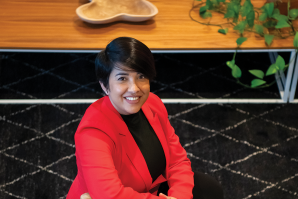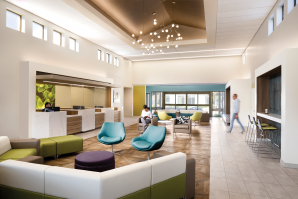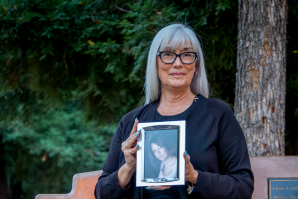Teresa Endres is a medical planner and architect working from the
Sacramento office of Taylor Design.

Lauren Wagner is currently a Sacramento-based architecture and
design representative for United Tile.

Based on our cancer journeys, we identified these six ways that healthcare facilities can ensure that they’re delivering the best possible cancer care:
Focus on life to foster hope. In some cancer care facilities, patients confront a jarring dichotomy between the welcoming, open and bright environment of the lobby, and the stark, foreboding settings of diagnostic and treatment areas where large, unnerving machines such as linear accelerators lurk. Equipment and safety requirements sometimes dictate the design, but to the extent possible, health care facilities should carry the theme of comfort and normalcy throughout the building. It is imperative for cancer patients wracked with doubt and fear to continuously experience a warm environment that encourages them to focus on hope and life. One design touch that we like to use is “a surprise around every corner” — which is usually a bright, cheery design element, piece of art or display that stirs and delights patients and visitors, easing stress and momentarily drawing their mind away from their situation.
Keep nature close. A good way to keep patients focused on life and recovery is by surrounding them with living things. Biophilic design promotes connectivity to the natural environment through features such as soothing outdoor views, healing gardens, purposeful landscaping, nature-inspired architecture and artwork, and interior design elements that mimic natural water flows and vegetation. This leans heavily into the scientifically proven evidence that access to nature and natural daylight calms the body, improves patient outcomes, reduces lengths of stay and patient readmissions, and improves staff satisfaction and retention.
Create abundant places for human contact. The COVID-19 pandemic taught many lessons, but as it relates to health care, none more than how important human contact is to recovery and well-being. Having cancer is a lonely experience even with people physically present. The pandemic deprived us of comforting contact with family and friends at the exact moment we needed it most. This reinforces the need for cancer care facilities to offer ample intimate places for families to meet, talk and show support — both inside and outside the patient room and building. Creating quiet waiting spaces where patients can potentially bond over their shared stories — similar to the concept of the casual workplace discussions that happen at the proverbial water cooler — is another way to encourage this essential human interaction.
Make privacy paramount. As irrational as it may sound, cancer patients often feel embarrassed by their disease. This can be compounded by well-meaning people who ask unnerving questions or pose ill-informed theories about the cause or prognosis. With feelings of uncertainty, anger and anxiety frequently swirling in their minds, cancer patients may prefer anonymity. For emotional as well as practical reasons such as infection control, multi-purpose health care facilities dedicate specific parking lots, entrances and waiting areas exclusively for cancer patients.
Prioritize patient safety. Given the breadth of types and conditions that exist within any sample of cancer patients, even “routine” procedures can quickly become emergencies. For example, during her second chemotherapy session, Lauren had an allergic reaction that required immediate aid. Infusion centers are commonly independent of hospital resources, so every second counts in an urgent situation that may require transportation to a hospital. Effective design practice ensures that attending staff can see the face of every infusion center patient to allow for immediate response and treatment if needed. This works both ways; the patient can be comforted by seeing the caregiver as well. Design strategies that illustrate such attention to detail and recognition of potential patient vulnerabilities must carry throughout the facility.
Exhibit true empathy from the parking lot to the treatment area. One of the greatest revelations of our experience was that the cancer patient’s experience begins even before stepping foot in the facility. The attitude of the parking lot attendants, the landscaping and the ease of entry — these all figure into the equation along with reception, exam and treatment rooms and so on. Health care facility leaders and designers need to understand the vital difference that true empathy can make to a cancer patient when it is delivered throughout their experience. They need to understand and empathize with a cancer patient’s sense of fear, anxiety and isolation, and then design health care environments that significantly reduce these feelings.
If you or a loved one is diagnosed with cancer, find a healthcare facility that provides sensitive, respectful and emotionally aware support. We are fortunate to have several in the Greater Sacramento area. And, as Lauren was told when diagnosed with breast cancer at age 31: “don’t write your obituary yet.” Stay strong and advocate fiercely for your own healthcare, particularly if you’re a woman.
Teresa fired four physicians over the course of three years before one took her seriously and diagnosed her uncommon combination of ovarian and uterine cancer. By then, the disease had spread and reached Stage 2B. But if we didn’t trust ourselves to know our own bodies, and press on in the face of initial skepticism – that we were too young for cancer or just needed to get in better shape – our cancer journeys may have gone very differently.
Teresa Endres is a medical planner and architect working from the Sacramento office of Taylor Design, an architecture, interior design and strategic planning firm with five California offices. Lauren Wagner previously worked as an interior designer for Taylor Design and is currently a Sacramento-based architecture and design representative for United Tile.
–
Stay up to date on business in the Capital Region: Subscribe to the Comstock’s newsletter today.
Recommended For You

These Female Financial Advisors Help Women Rethink Their Relationship With Money to Build Wealth
The faces of entrepreneurship and wealth holding are changing as women make gains in both facets of economic life. These shifts are affecting how they’re managing money — and who they turn to for help.

Healing Grounds
Today’s health care architecture provides a holistic, calming environment
Stark and sterile health care buildings are falling by the
wayside as architecture firms design for a more
supportive patient experience.

The Way We Work: Kenny Pawlek
A glimpse into the daily life of the administrator at Shriners Children’s Northern California
Pawlek keeps that positive outlook through all aspects of managing the 800-employee operation. One secret to keeping a positive morale: lots of dad jokes.

The Life-Saving Organ Trail
How new technology is helping transplant centers send and receive organs from great geographic distances
In 2022, the United States Food and Drug Administration approved the TransMedics Organ Care System, or OCS device. Known as the “heart in a box,” this device uses normothermic perfusion to pump blood through a removed heart and preserve it for longer periods until it can be transplanted into a new person.



